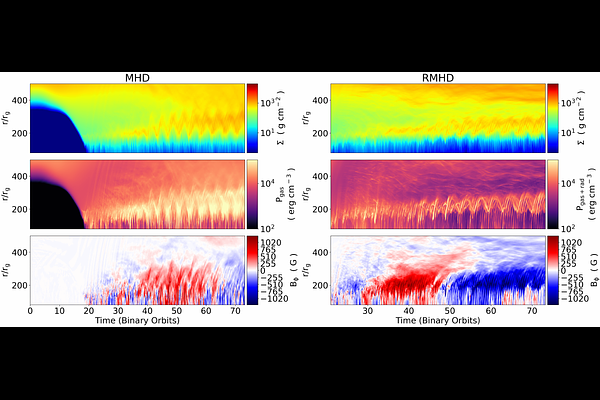Radiation Magnetohydrodynamic Simulation of sub-Eddington Circumbinary Disk around an Equal-mass Massive Black Hole Binary

Radiation Magnetohydrodynamic Simulation of sub-Eddington Circumbinary Disk around an Equal-mass Massive Black Hole Binary
Vishal Tiwari Georgia Institute of Technology, Chi-Ho Chan Georgia Institute of Technology, Tamara Bogdanović Georgia Institute of Technology, Yan-Fei Jiang Center for Computational Astrophysics, Flatiron Institute, Shane W. Davis University of Virginia, Simon Ferrel Georgia Institute of Technology
AbstractWe present the first three-dimensional radiation magnetohydrodynamic (RMHD) simulation of a sub-Eddington circumbinary disk (CBD) around an equal-mass massive black hole binary (MBHB) with a total mass of $2\,\times\,10^7\,M_{\odot}$ on a circular orbit, separated by 100$\,GM_{\rm tot}/c^2$. The inclusion of radiation leads to a denser, thinner, and more filamentary disk compared to non-radiative magnetohydrodynamic simulation, primarily due to reduced pressure support and an altered equation of state. The RMHD disk also features $\sim 3$ times lower accretion rate ($\approx 0.15\,\dot{M}_{\rm Edd}$), weaker accretion streams and a less pronounced overdensity (a.k.a., ``lump") at the inner edge. Our analysis of the light curves and thermal spectra reveals that the variability induced by the binary-CBD interaction is distinguishable in the optical/UV band, where CBD shines at about $1\%$ of the Eddington luminosity. These findings underscore the crucial role of radiation on the structure and observational properties of CBDs around massive black hole binaries and have implications for detecting electromagnetic counterparts to LISA gravitational wave precursors, and for heavier binaries that are Pulsar Timing Array sources.